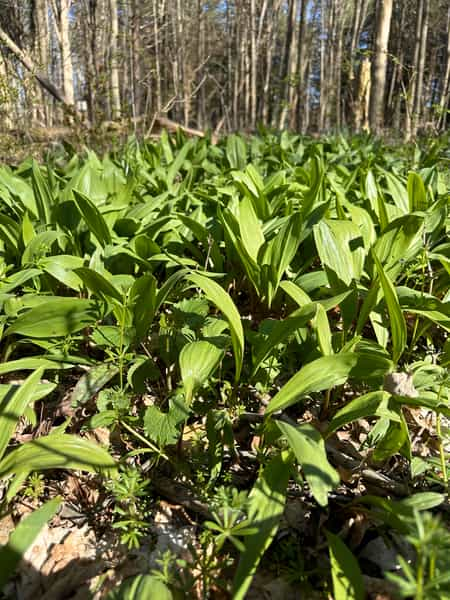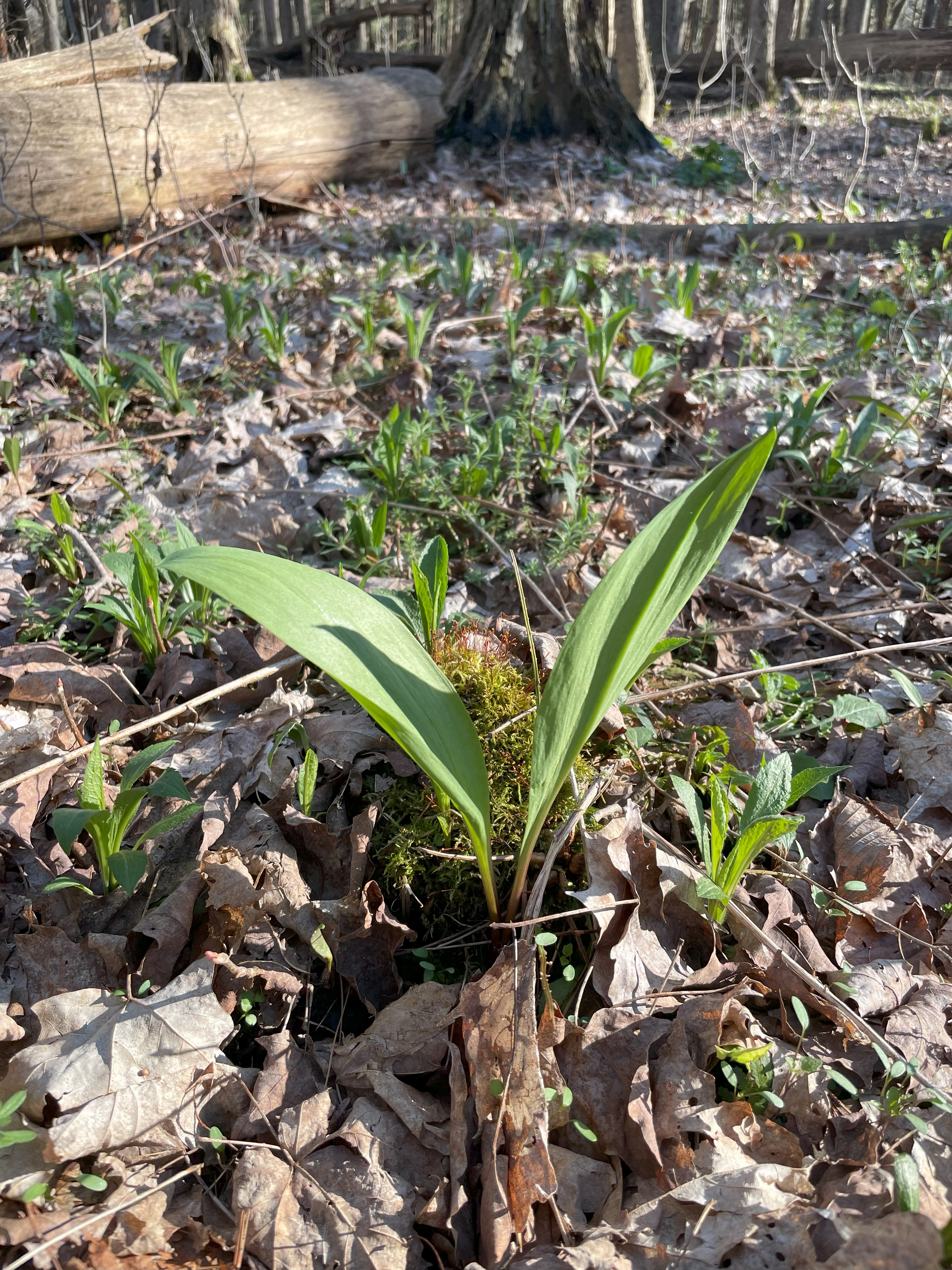Ramps: Not Just a Plane With a Constant Slope Between Two Points

Spring is home to a class of plants that are perhaps the most magical we get all year: the ephemerals. These are plants that appear briefly as the weather begins to warm, then disappear into dormancy for the remainder of the year. Some of these are well known and beloved like crocuses and daffodils. But there are a whole range of ephemerals that are prized for their culinary uses.
 Most famous of these is probably asparagus (though their season is long enough that it could be argued they aren’t true ephemerals), but there are also fiddlehead ferns, morel mushrooms, nettles, henbit, dandelions, spruce tips, and of course, the crown jewel of edible ephemera: ramps.
Most famous of these is probably asparagus (though their season is long enough that it could be argued they aren’t true ephemerals), but there are also fiddlehead ferns, morel mushrooms, nettles, henbit, dandelions, spruce tips, and of course, the crown jewel of edible ephemera: ramps.
 A ramp
A ramp
Ramps are wild onions. If you live in the Chicago area, then you may already know the place is named for them. The name Chicago comes from an indigenous word for the adorable allium (shikaakwa), so plentiful were they in the area once upon a time. If you've never tasted one before, ‘wild onion’ doesn't quite do it justice. In my opinion, they are the most delicious member of the allium genus. They have more of a garlicky edge than a typical onion, and much more flavor than a scallion. However their flavor is less harsh and more balanced when raw than a shallot. They really have a best-of-all-worlds flavor profile. It's no wonder, then, that they have become a favorite harbinger of warmer weather among many restaurant chefs; especially with their added cache of being a wild crop. This, however, has been largely to their detriment.

The ramp patch in the woods behind our house
In recent decades, the explosion of ramps’ popularity has seen their numbers diminish dramatically. They typically fetch anywhere from $12-$25/lb when sold to restaurants or at market. This combined with their ease of harvest and the fact that they grow in easy to access areas has made them a perennial victim of over-harvesting. This is especially problematic because ramps are slow to establish. Once a patch is depleted it can take years for it to come back, if it ever does. For this reason many responsible foragers have urged folks to simply not harvest them, some going so far as to say you shouldn’t be buying ramps gathered by others either. They want to de-incentivize those that would over-harvest by diminishing the demand.
While well-intentioned, to me, this is just unrealistic. People have been harvesting and eating ramps as a staple of their spring diets for millennia. The demand for ramps just isn’t going away. Campaigns like this have been attempted with other food products as well. Bluefin tuna, for example, is closer than ever to extinction due to overfishing and there have been high profile folks in the food industry encouraging a boycott of its consumption, yet simply looking at its prevalence on menus across the globe today is evidence enough of this effort's categorical failure. Rather than trying to enforce a social ban on these products, we should instead be encouraging responsible harvesting. Thankfully with ramps, sustainable harvest is actually way easier than extractive harvest, and more and more folks who harvest ramps to sell are deciding to do so in a responsible way.
So, what is the responsible way to harvest ramps? Simple: only take the leaves, take only one leaf per plant (they only have two leaves to begin with), and harvest no more than 10-15% of any given patch. Following these guidelines ensures the ramps continue to multiply year-upon-year while you still get to enjoy their wonderful flavor as an addition to your spring diet. The leaves can be used in much the same way as you would the whole plant, but to get you started on your ramp leaf journey here is my recipe for ranch dressing using ramps. It's real good.
 Everything green in these two photos are ramps
Everything green in these two photos are ramps
 With a patch this size, on private property (meaning low likelihood of other harvesters), collecting some bulbs as well as leaves is probably fine
With a patch this size, on private property (meaning low likelihood of other harvesters), collecting some bulbs as well as leaves is probably fine
Ramp Ranch Dressing
Scroll down for a printable version of this recipe
Yield: about 2 cups
Active time: 5 minutes
2 cups ramp leaves
2 sprigs parsley
1 Tablespoon Dijon mustard
1/2 cup sour cream
1/2 cup buttermilk
1/2 cup mayo
1/4 teaspoon black pepper
1/2 teaspoon lemon juice or to taste
Salt, to taste
1/2 teaspoon MSG (optional)
1. Bring a pot of salted water to a boil and blanch ramp leaves and parsley for about 15-30 seconds. Remove from water and submerge in an ice bath to rapidly chill.
2. Wring as much excess water from the ramp leaves and parsley as possible, then add them to the pitcher of a blender. Follow with the remaining ingredients and blend on high until smooth and green in color (1-2 minutes depending on the power of your blender).
3. Adjust seasoning as necessary and enjoy! This will keep in your fridge for about a week.
I hope this post inspired you to get into the great outdoors this spring and avail yourself of nature’s bounty in a respectful and responsible manner. Spring really is a special season for anyone who loves food, and products like ramps are a big part of the reason why. If you want to hone your spring repertoire even further why not check out our upcoming Spring Dinner Party class. Happy hunting!

Ramp Ranch Dressing
Ingredients
- 2 cups ramp leaves
- 2 sprigs parsley
- 1 Tablespoon Dijon mustard
- 1/2 cup sour cream
- 1/2 cup buttermilk
- 1/2 cup mayo
- 1/4 teaspoon black pepper
- 1/2 teaspoon lemon juice or to taste
- Salt, to taste
- 1/2 teaspoon MSG (optional)
Instructions
- Bring a pot of salted water to a boil and blanch ramp leaves and parsley for about 15-30 seconds. Remove from water and submerge in an ice bath to rapidly chill.
- Wring as much excess water from the ramp leaves and parsley as possible, then add them to the pitcher of a blender. Follow with the remaining ingredients and blend on high until smooth and green in color (1-2 minutes depending on the power of your blender).
- Adjust seasoning as necessary and enjoy! This will keep in your fridge for about a week.

